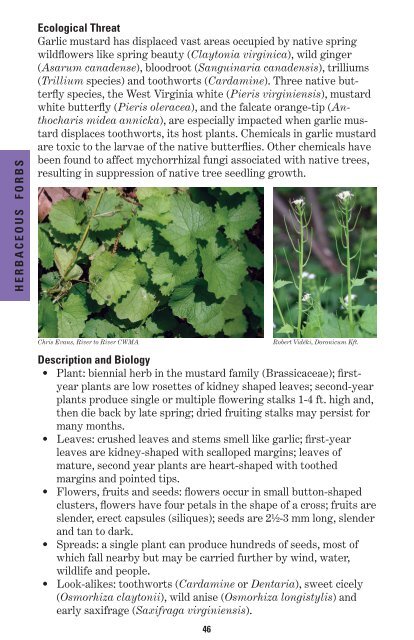Plant Invaders of Mid-Atlantic Natural Areas - National Park Service
Plant Invaders of Mid-Atlantic Natural Areas - National Park Service
Plant Invaders of Mid-Atlantic Natural Areas - National Park Service
Create successful ePaper yourself
Turn your PDF publications into a flip-book with our unique Google optimized e-Paper software.
HERBACEOUS FORBS<br />
Ecological Threat<br />
Garlic mustard has displaced vast areas occupied by native spring<br />
wildflowers like spring beauty (Claytonia virginica), wild ginger<br />
(Asarum canadense), bloodroot (Sanguinaria canadensis), trilliums<br />
(Trillium species) and toothworts (Cardamine). Three native butterfly<br />
species, the West Virginia white (Pieris virginiensis), mustard<br />
white butterfly (Pieris oleracea), and the falcate orange-tip (Anthocharis<br />
midea annicka), are especially impacted when garlic mustard<br />
displaces toothworts, its host plants. Chemicals in garlic mustard<br />
are toxic to the larvae <strong>of</strong> the native butterflies. Other chemicals have<br />
been found to affect mychorrhizal fungi associated with native trees,<br />
resulting in suppression <strong>of</strong> native tree seedling growth.<br />
Chris Evans, River to River CWMA Robert Vidéki, Doronicum Kft.<br />
Description and Biology<br />
• <strong>Plant</strong>: biennial herb in the mustard family (Brassicaceae); firstyear<br />
plants are low rosettes <strong>of</strong> kidney shaped leaves; second-year<br />
plants produce single or multiple flowering stalks 1-4 ft. high and,<br />
then die back by late spring; dried fruiting stalks may persist for<br />
many months.<br />
• Leaves: crushed leaves and stems smell like garlic; first-year<br />
leaves are kidney-shaped with scalloped margins; leaves <strong>of</strong><br />
mature, second year plants are heart-shaped with toothed<br />
margins and pointed tips.<br />
• Flowers, fruits and seeds: flowers occur in small button-shaped<br />
clusters, flowers have four petals in the shape <strong>of</strong> a cross; fruits are<br />
slender, erect capsules (siliques); seeds are 2½-3 mm long, slender<br />
and tan to dark.<br />
• Spreads: a single plant can produce hundreds <strong>of</strong> seeds, most <strong>of</strong><br />
which fall nearby but may be carried further by wind, water,<br />
wildlife and people.<br />
• Look-alikes: toothworts ( Cardamine or Dentaria), sweet cicely<br />
(Osmorhiza claytonii), wild anise (Osmorhiza longistylis) and<br />
early saxifrage (Saxifraga virginiensis).<br />
46

















